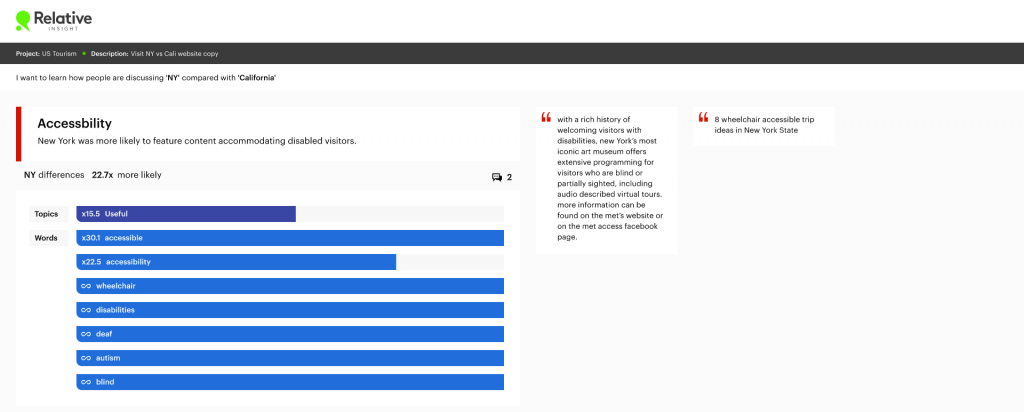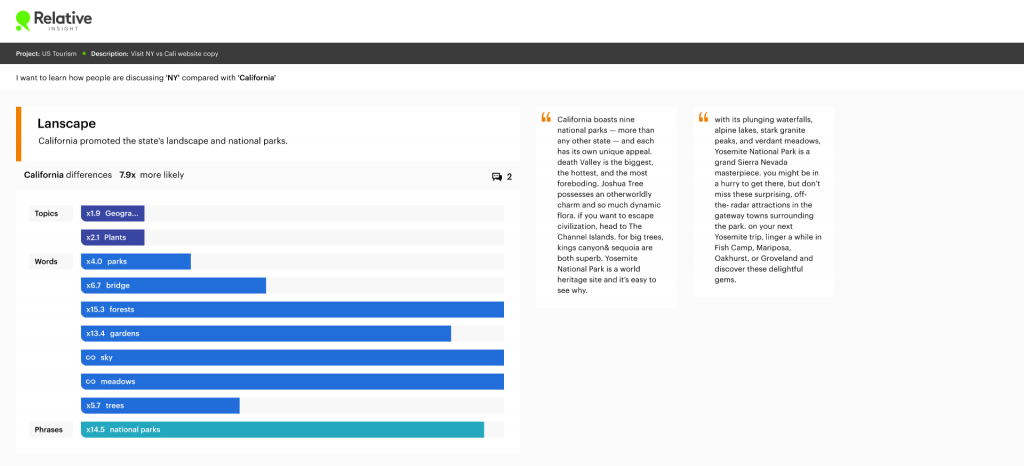How US tourism marketing differs by state

The US is big, like really big. Like 40x the size of the UK big. That means there’s a lot of land to explore – but it also means a lot of states competing to win your US tourism $$$.
Brands use Relative Insight to understand competitor landscape by comparing their own marketing materials and comms to those of specific competitors or to that of the industry at large. We used competitor website analysis on Visit California and I Love NY – each state’s respective US tourism board – to qualify the specific language they use to attract visitors.
Relative Insight’s approach to text analysis compares two or more textual data sets to pinpoint the linguistic attributes unique to each. This NLP technique analyzes words through the lens of contextual understanding to discover the differences in topics, words, phrases, grammar and emotion.
Using Relative Insight to compare New York and California will allow us to look beyond general travel terms both states likely use – revealing what makes the east and west coast unique.
New York
On the East Coast, we observed more emphasis on cultural events and things to do. Website copy promoted arts and entertainment happenings, using the words art, performances, concerts and broadway.

In line with this cultural theme, I Love NY promoted the state’s culinary achievements and heritage. New York is of course known for bagels and pizza, but we also saw mentions of delicious beer, wine, cookies and sausage.
Our competitor website analysis found New York State tourism 22.7x more likely to talk about accessibility and publish online content accommodating visitors with disabilities. Blog posts included travel suggestions for blind, deaf, autistic and wheelchair using tourists.

California
We observed one underlying theme across all Visit California promotional materials – the environment. This theme presented itself in a few different ways, with the first being an emphasis on water, as Cali was more likely to use words like ocean, pier, springs and coast. While both states are coastal, California boasts 840 miles of coastline, while New York spans 520 miles.

In our competitor website analysis, the next environmental insight we found is the influence of state landscape and parks. California was 7.9x more likely to talk of forests, gardens, meadows, trees and national parks. This seems fitting as California includes nine national parks, more than any other state.

Finally, California used descriptive language to promote these natural sights. Website copy included the words colorful, rugged, beautiful, lush, rustic and lavish. California paints a vivid picture of the state’s scenery to entice new visitors.
Both states took a different approach to US tourism marketing – New York used more informational language, while California opted for a descriptive tone of voice. Competitor website analysis helps pinpoint what exactly makes a brand unique, and gives them the insight to adopt strategies from successful competitors.
Relative Insight can analyze website copy for any industry – food, education, beauty and more. This insight helps us understand a brand’s unique tone of voice and persona used to attract customers.